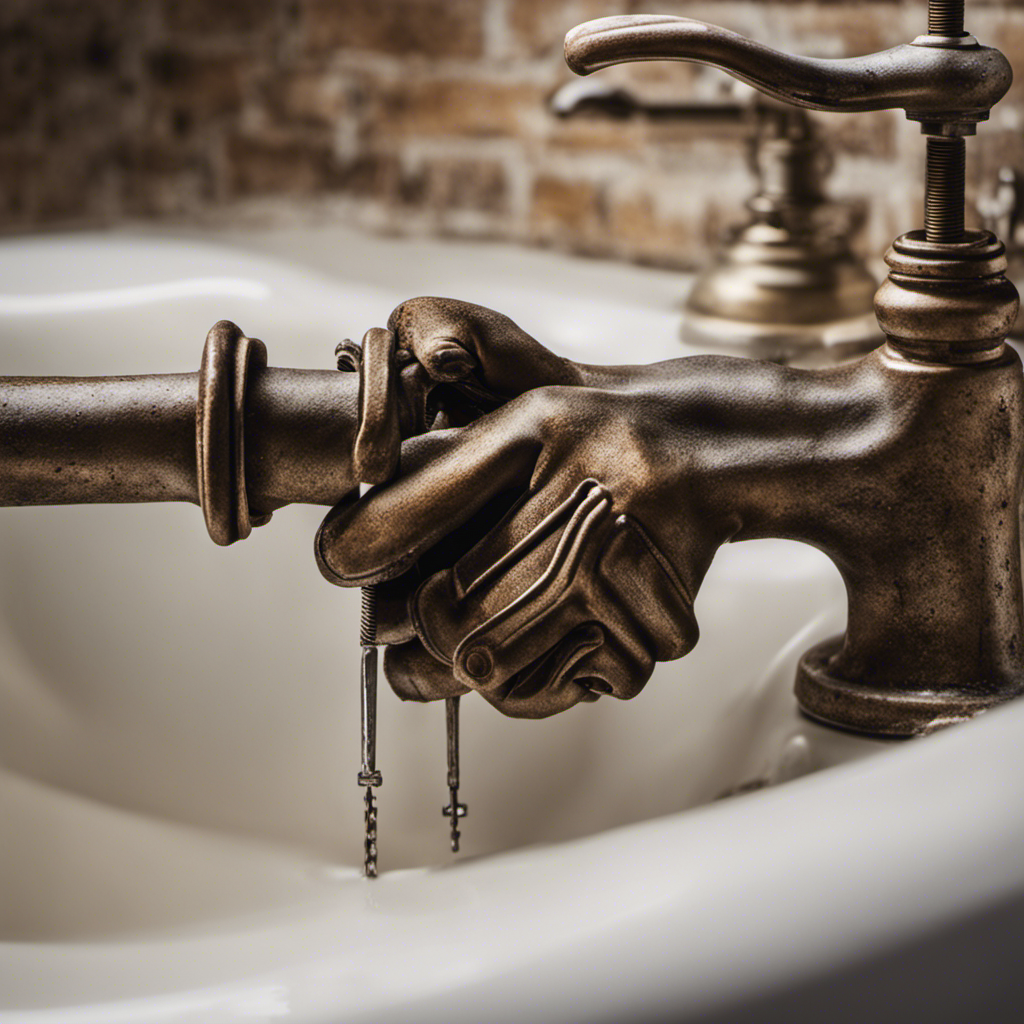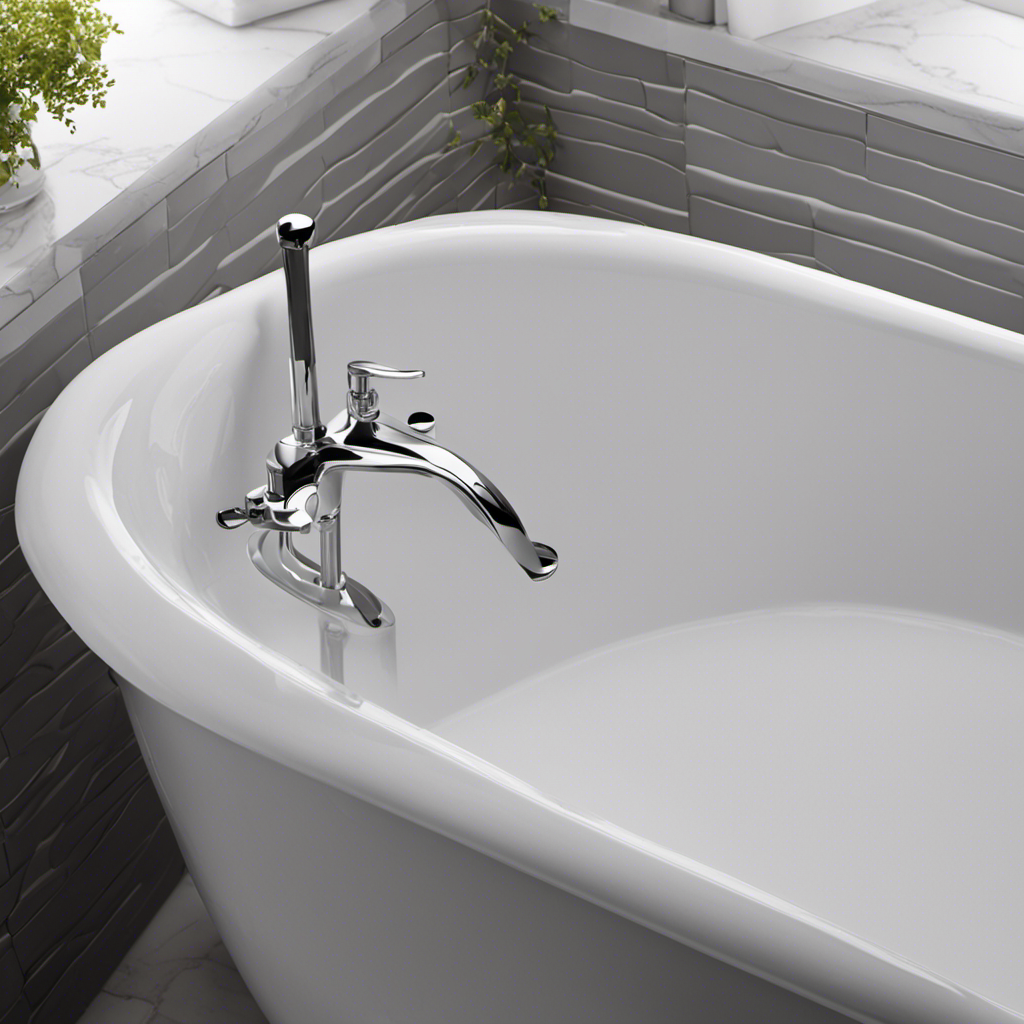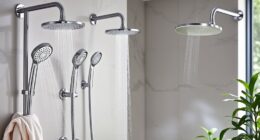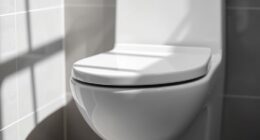As I stood there, staring at my clogged bathtub drain, I knew I had to take action. With water pooling around my feet, I gathered my tools and prepared to tackle the problem head-on.
In this article, I’ll share with you my tried-and-true methods for unclogging an old bathtub drain. From assessing the clog to using a homemade drain cleaner and plunging, I’ll guide you through each step.
So, let’s roll up our sleeves and get that drain flowing smoothly again!
Key Takeaways
- Assess the drain for any obvious blockages and remove visible obstructions.
- Use homemade drain cleaners like baking soda and vinegar or salt and boiling water.
- Try using a plunger to dislodge the clog, ensuring a proper seal and applying forceful strokes.
- If DIY methods fail, seek professional help to address extensive damage or recurring clogs.
Assessing the Clog
You should start by feeling for any obvious blockages in the drain using your fingers. This step is important because it allows you to identify the causes of bathtub clogs. Common culprits include hair, soap residue, and small objects that may have accidentally fallen into the drain.
If you can feel any blockages, try to remove them gently with your fingers. Once you have cleared any visible obstructions, it’s important to take preventative measures to avoid future clogs. One tip is to use a drain cover or strainer to catch hair and other debris before it goes down the drain. Another helpful tip is to regularly clean the drain by pouring boiling water down it or using a mixture of baking soda and vinegar to dissolve any buildup.
These simple steps can help keep your bathtub drain clear and prevent future clogs.
Gathering Necessary Tools
To gather the necessary tools for the job, first, grab a plunger and a pair of rubber gloves. These tools are essential for tackling a clogged bathtub drain.
However, there may be instances where these conventional methods don’t work, and that’s when finding alternative solutions becomes crucial. Understanding common causes of bathtub clogs can help in determining the most effective approach.
Hair buildup, soap scum, and mineral deposits are often the culprits behind clogged drains. By addressing these issues, one can prevent future clogs and ensure smooth drainage.
Now, let’s move on to applying a homemade drain cleaner, which is another effective way to tackle stubborn clogs and maintain a clean and functioning bathtub drain.
Applying a Homemade Drain Cleaner
Now let’s see how we can effectively use a homemade drain cleaner to tackle those stubborn clogs and keep our bathtub drain clean and functional.
Here are some alternative drain cleaning methods that you can try at home:
-
Baking soda and vinegar: Mix 1/2 cup of baking soda with 1/2 cup of vinegar. Pour the mixture down the drain and let it sit for 30 minutes. Then, flush it with hot water to clear the clog.
-
Salt and boiling water: Pour 1/2 cup of salt down the drain, followed by boiling water. The salt will help dissolve the clog while the hot water flushes it away.
-
Baking soda and lemon juice: Mix 1/2 cup of baking soda with the juice of one lemon. Pour the mixture down the drain and let it sit for 15 minutes. Then, flush it with hot water.
Remember to take precautions when using homemade drain cleaners. Avoid using them if you have PVC pipes as they may damage them. Also, always wear gloves and protective eyewear to prevent any irritation or accidents.
Using a Plunger
If there is still standing water in your bathroom sink, try using a plunger to dislodge the clog.
Plungers are a simple and effective tool for unclogging drains, and they can often solve the problem without the need for harsh chemicals or expensive plumbing services.
To use a plunger, first make sure there is enough water in the sink to cover the plunger cup. Then, place the plunger over the drain and push down firmly, creating a seal.
Begin plunging vigorously, using quick, forceful strokes. The suction created by the plunger will help to dislodge the clog and allow the water to flow freely again.
If the clog persists, you can try alternative methods such as using a drain snake or a mixture of baking soda and vinegar.
Common mistakes to avoid when using a plunger include not creating a proper seal, not plunging with enough force, or using a plunger that is too small.
Seeking Professional Help if Necessary
Seeking professional help may be necessary if the clog in your bathroom sink persists despite your attempts to unclog it yourself. When it comes to plumbing issues, sometimes DIY methods just don’t cut it.
Here are some reasons why calling a plumber might be the best solution:
-
Extensive damage: If the clog is causing damage to your pipes or other parts of your plumbing system, it’s time to call in the experts. Ignoring the issue could lead to costly repairs down the line.
-
Recurring clogs: If you’ve tried multiple DIY methods and the clog keeps coming back, it’s a sign of a deeper problem. A plumber can identify the root cause and provide a long-term solution.
-
Lack of tools or expertise: Some clogs require specialized tools or knowledge to remove. Plumbers have the necessary equipment and skills to tackle even the toughest clogs.
Frequently Asked Questions
What Are Some Common Signs of a Clogged Bathtub Drain?
When my bathtub drain gets clogged, I notice water pooling at my feet, slow drainage, and a foul odor. To prevent clogged drains, avoid hair and soap buildup by using a drain cover and regular cleaning.
Can I Use a Chemical Drain Cleaner Instead of a Homemade One?
Can I use a chemical drain cleaner instead of a homemade one? Well, the pros of chemical drain cleaners are convenience and speed, but the cons include potential damage to pipes and harm to the environment.
How Long Should I Wait Before Using the Plunger if the Homemade Drain Cleaner Doesn’t Work?
If the homemade drain cleaner doesn’t work, I’ll wait for about 15 minutes before using the plunger. It’s important to use the plunger correctly, applying downward pressure to create suction and dislodge the clog. To prevent bathtub drain clogs, regularly remove hair and debris from the drain.
Are There Any Specific Safety Precautions I Should Take When Using a Plunger on a Bathtub Drain?
When using a plunger on a bathtub drain, it’s important to take safety precautions. Wear gloves to protect your hands, avoid using harsh chemicals, and be cautious not to splash water onto yourself.
How Do I Know When It’s Time to Call a Professional Plumber for a Clogged Bathtub Drain?
When my bathtub drain is clogged, I know it’s time to call a plumber if I notice signs like slow draining, gurgling sounds, or foul odors. These indicate a more serious clog that requires professional assistance.
Conclusion
In conclusion, unclogging an old bathtub drain can be done with a few simple steps and the right tools. By assessing the clog and using a homemade drain cleaner or a plunger, you can often clear the blockage yourself.
However, if the clog persists, it may be necessary to seek professional help. For example, my neighbor had an old bathtub drain that was completely blocked. After trying a homemade drain cleaner and using a plunger, they decided to call a plumber who successfully cleared the clog using professional tools.










